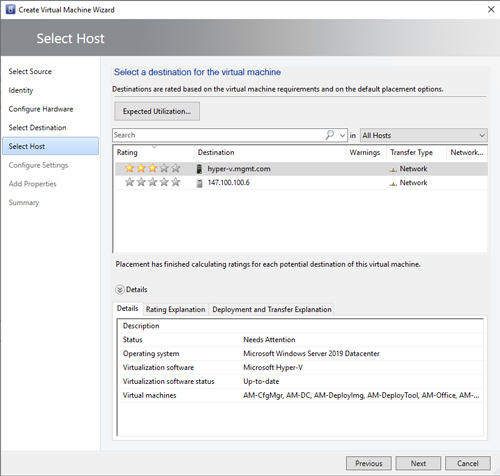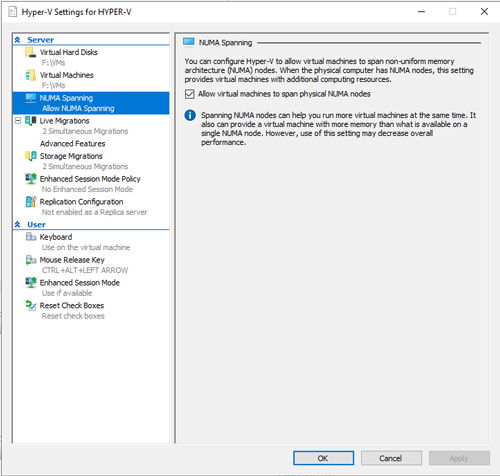Posey's Tips & Tricks
What Causes SCVMM To Give a Host Zero Stars
System Center Virtual Machine Manager will sometimes flag a Hyper-V host with zero stars even if the host is online and healthy. Here's how to identify the problem.
One of the best things about System Center Virtual Machine Manager (SCVMM) is its ability to create new virtual machines (VMs) from templates. After all, generating a VM from a template is quicker and easier than setting up a VM from scratch.
However, things do not always go smoothly with this process.
There is a point in the VM-creation process where you must choose the host on which the VM will be deployed. When you reach this point, SCVMM will display a list of your Hyper-V hosts. Each host will be accompanied by a star rating that reflects the host's ability to accommodate the new VM. You can see this in Figure 1.
 [Click on image for larger view.] Figure 1: You must select the host where your new VM will reside.
[Click on image for larger view.] Figure 1: You must select the host where your new VM will reside.
As you look at the figure above, you will notice that one of the hosts has a rating of zero stars. I intentionally took this host offline because I wanted to show you what a zero-star rating looks like. Sometimes, though, a zero-star rating can occur even though the host is online and healthy.
In my experience, tracking down the cause of the zero-star rating can be tricky. Even so, there are some things you should look for. First, as I mentioned, make sure the host is online and the Hyper-V is running. It's also worth making sure the host is not currently in maintenance mode, because hosts in maintenance mode will automatically receive a zero-star rating.
Assuming the host is online, check how much storage space is available to the host. Hyper-V VMs are created with dynamically expanding virtual hard disks by default. This means the virtual hard disk file gets larger over time as data is added to the virtual hard disk. I have run into a few situations in which a Hyper-V server unexpectedly ran out of storage space. Even if a Hyper-V host doesn't run completely out of space, SCVMM might still flag it with a zero-star rating if it senses the available storage might be inadequate.
Inadequate memory is another common cause of a zero-star rating. Simply put, the Hyper-V host must have enough free memory available to accommodate the VM you are creating. In some cases, however, SCVMM might produce a zero-star rating even if it seems that a sufficient amount of memory is available.
There are three things that I know can cause this. First, the Hyper-V host has to have enough memory to run the newly created VM, but it also must have enough memory left over to run the host operating system. You can end up with a zero-star rating if the host server doesn't have quite enough memory to run everything it needs to.
The second thing that can cause a memory-related zero-star rating is if there is sufficient memory available on the Hyper-V host, but that memory is scattered across multiple NUMA nodes. It's best (from a performance standpoint) to limit a VM to using a single NUMA node, but Hyper-V does include a setting you can use to allow a VM to span NUMA nodes, as shown in Figure 2.
 [Click on image for larger view.] Figure 2: You can span VMs across multiple NUMA nodes.
[Click on image for larger view.] Figure 2: You can span VMs across multiple NUMA nodes.
The third memory-related cause is something that is a bit more difficult to explain. Occasionally, I have seen situations in which a host received a zero-star rating despite having plenty of resources available. I was able to work around the problem by rebooting the host. Obviously, this isn't something that happens all the time, but I have encountered it often enough that I wanted to mention it.
Generally speaking, the most common reason for a host receiving a zero-star rating is that it lacks something that the VM requires. For instance, if the VM is meant to be highly available, Hyper-V hosts that are not part of a cluster will receive a zero-star rating. Similarly, a VM that requires a physical GPU cannot be placed on a host that lacks the required GPU hardware.
About the Author
Brien Posey is a 22-time Microsoft MVP with decades of IT experience. As a freelance writer, Posey has written thousands of articles and contributed to several dozen books on a wide variety of IT topics. Prior to going freelance, Posey was a CIO for a national chain of hospitals and health care facilities. He has also served as a network administrator for some of the country's largest insurance companies and for the Department of Defense at Fort Knox. In addition to his continued work in IT, Posey has spent the last several years actively training as a commercial scientist-astronaut candidate in preparation to fly on a mission to study polar mesospheric clouds from space. You can follow his spaceflight training on his Web site.